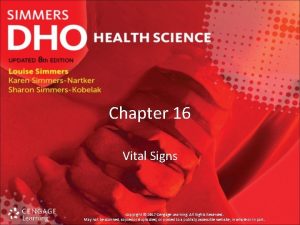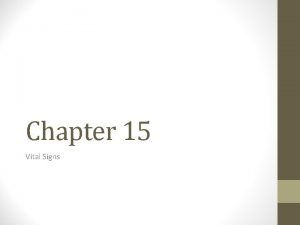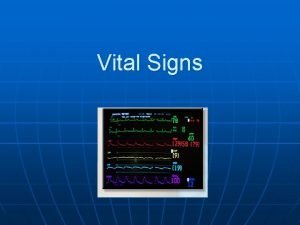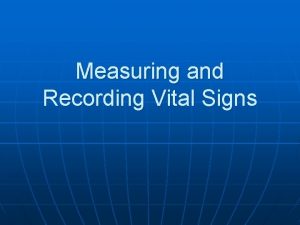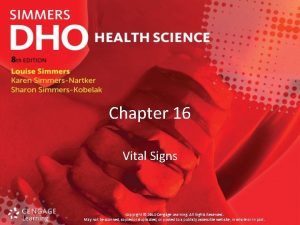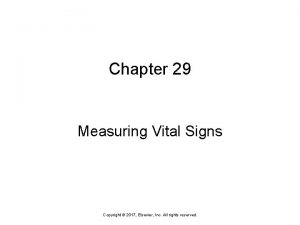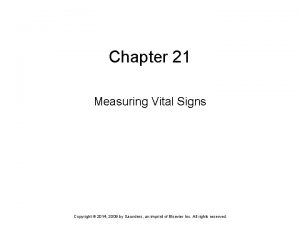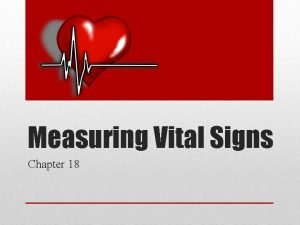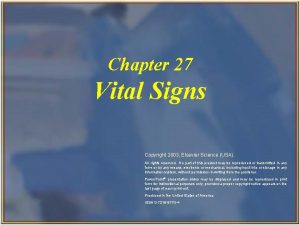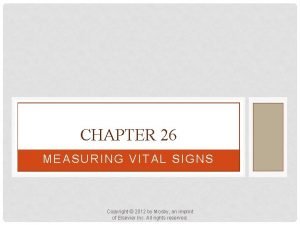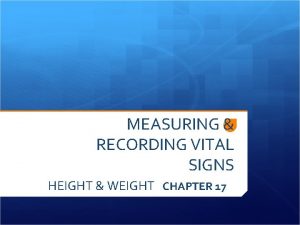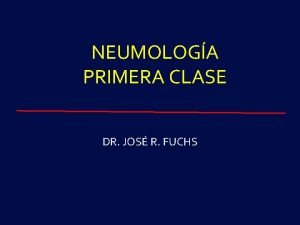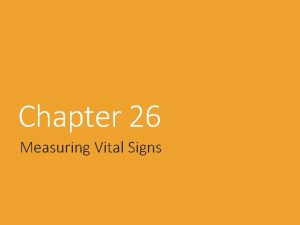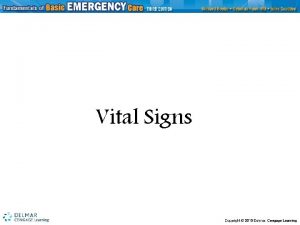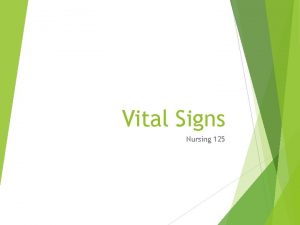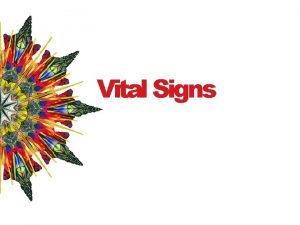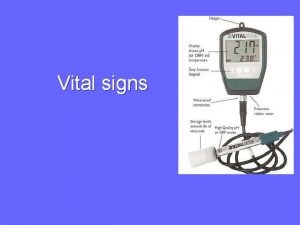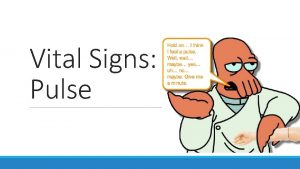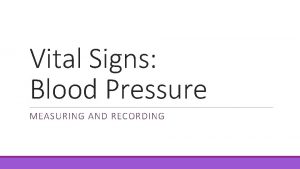Vital Signs Pulse MEASURING AND RECORDING Pulse Pressure


















- Slides: 18

Vital Signs: Pulse MEASURING AND RECORDING

Pulse ØPressure of blood pushing against artery walls as heart contracts ØAbbreviated=P or HR ØCan be auscultated (listened to) or palpated (felt) ØMore easily palpated in arteries that lie close to the skin & can be pressed against a bone by the fingers ØPalpate by using your 1 st and 2 nd fingers ØNever palpate with your thumb; it has a pulse that can be confused with the pt’s pulse

Pulse ØMajor arterial pulse sites: 1. Temporal=on either side of the forehead 2. Carotid=at the neck on either side of the trachea 3. Brachial=inner aspect of forearm at antecubital space; often used in very young children before the brachial muscle is developed 4. Radial=inside the wrist, near the thumb; pulse rate is usually measured here

Pulse ØMajor arterial pulse sites: 5. Femoral=inner aspect of upper thigh where thigh joins with the trunk of the body 6. Popliteal=behind the knee 7. Dorsalis pedis=at the top of the foot arch 8. Posterior tibial=inner aspect of ankle


Pulse Chararcteristics ØWhen measuring pulse, assess for these characteristics: 1. Rate 2. Rhythm 3. Volume 4. Bilateral presence

Pulse Rate ØMeasured in beats per minute=BPM ØRates vary, depending on age, sex, body size, activity, diseases, and medications ØAs the CV system matures as we grow, the pulse rate decreases ØWomen usually have faster rate than men ØCount the pulse for 15, 20, 30, or 60 seconds ØThen multiply to find the bpm

Pulse Rate ØIf you count 90 for 60 seconds, what is the bpm? 90 bpm ØIf you count 40 for 30 seconds, what is the bpm? 80 bpm ØIf you count 20 for 20 seconds, what is the bpm? 60 bpm ØIf you count 25 for 15 seconds, what is the bpm? 100 bpm

Pulse Rate ØAdults: 60 -100 bpm ØChildren aged >7: 70 -100 bpm ØChildren aged 1 -7: 80 -110 bpm ØInfants: 100 -160 bpm

Pulse Rate ØBradycardia: pulse rate under 60 bpm Seen in physically fit athletes, pts taking heart meds, pts experiencing severe lack of oxygen or BP ØTachycardia: pulse rate over 100 bpm (except in children) Seen if having physical, emotional, or mental stress (infection, pain, exercise, dealing with crying baby), or experiencing severe lack of oxygen or low BP

Pulse Rhythm ØThe regularity of the pulse or spacing of heartbeats ØDescribed as regular or irregular ØArrhythmia or dysrhythmia=irregular or abnormal rhythm ØIf rhythm is irregular, it should be counted for a full minute ØIrregular rhythms can be caused by defect in electrical conduction pathway, medications, lack of oxygen, or it can be a normal condition in infants

Pulse Volume ØStrength or intensity of the pulse ØDescribed as strong/normal, weak/thready, or bounding/full

Bilateral Presence ØBoth sides of the body should have the same rate, rhythm, and volume ØIf a pulse is only on one side of the body, it should be documented as unilateral

Recording Pulse ØWhen recording a pulse, include the rate, rhythm, and volume ØExamples: P 82, strong and regular P 76, weak and irregular

Apical Pulse ØPulse count auscultated with stethoscope at apex of heart ØAssessed with pts who have irregular heartbeats, hardening of the arteries, weak or rapid pulses ØAssessed in children & infants due to their rapid pulse is easier to count while listening rather than palpating ØMust be assessed before giving certain drugs that can slow the heart rate or if pulse deficit is being checked ØPulse deficit=when there is a difference in the rate of radial and apical pulses

Apical Pulse ØFound at the 5 th-6 th intercostal space on the midclavicular line ØWarm the diaphragm of the stethoscope by rubbing it on the palm of your hand ØGive infant a pacifier, calm the child, or ask the adult not to talk so you can hear the apical pulse Ø 2 separate sounds are heard=“lub-dub”

Apical Pulse ØEach “lub-dub” is one contraction and counted as 1 beat Ø“Lub-dub” sounds are caused by the closing of the heart valves as blood flows through the chambers ØCount for 1 full minute ØRecord “AP” or “apical” next to the rate

 Chapter 14:1 measuring and recording vital signs
Chapter 14:1 measuring and recording vital signs Chapter 16:2 measuring and recording temperature
Chapter 16:2 measuring and recording temperature Chapter 16:1 measuring and recording vital signs
Chapter 16:1 measuring and recording vital signs Measuring and recording vital signs
Measuring and recording vital signs Measuring and recording vital signs
Measuring and recording vital signs Chapter 15:3 measuring and recording pulse
Chapter 15:3 measuring and recording pulse Chapter 16:7 measuring and recording blood pressure
Chapter 16:7 measuring and recording blood pressure 2009 delmar cengage learning
2009 delmar cengage learning Recording vital signs
Recording vital signs Measuring and recording blood pressure
Measuring and recording blood pressure Chapter 29 measuring vital signs
Chapter 29 measuring vital signs Chapter 21 measuring vital signs
Chapter 21 measuring vital signs Baseline vital signs
Baseline vital signs Respiratory number 18
Respiratory number 18 Chapter 27 measuring vital signs
Chapter 27 measuring vital signs Apical radial pulse
Apical radial pulse Divided highway begins sign
Divided highway begins sign Chapter 21:1 measuring/recording height and weight
Chapter 21:1 measuring/recording height and weight Capacidad vital y capacidad vital forzada
Capacidad vital y capacidad vital forzada

